#there is some overlap between the three categories
Explore tagged Tumblr posts
Text
Not to beat a dead horse, but the naming conventions in the Magnus Archives are truly delightful. Jonny really said, “Here’s a cast of fascinating characters! Their names are:
My actual full legal name
The first names of my friends + the last names of famous horror writers
Michael (x4)
They all die horrible deaths :)”
#there is some overlap between the three categories#jon and at least one of the michaels also have the last names of famous horror writers#tma#the magnus archives#jonathan sims#sasha james#tim stoker#martin blackwood#michael shelley#mike crew
14K notes
·
View notes
Text
Hello and welcome to the Les Mis Shipping Showdown!
That's right, we're bringing ship brackets to the Les Mis fandom! The Shipping Showdown is an all new, 5 round contest intended to answer some of the internet's greatest questions, such as "is E/R's dominance really as overwhelming as AO3 statistics would have you believe?", "what is the fandom's all time favourite Les Amis pair the spares combo?", and "what would happen if we tried to Jurassic Park the ship wars of 2013 back into existence 12 years later?". Ignore that last one, maybe.
The voting portion of the Les Mis Shipping Showdown is now complete - congratulations to our winners, Enjolras/Grantaire!
We have also now completed Steal Off 2 - click here to see the results and here if you're interested in stats about the whole stealing process!
Ideas for further activities are in the pipeline so please watch this space for more details!
CURRENT BRACKET BELOW:

Please see below the cut for FAQ, rules, and mod details:
FREQUENTLY ASKED QUESTIONS
Q: Who is responsible for all this? Great question! The Les Mis Shipping Showdown is the brainchild of @lonelyroommp3, with invaluable assistance including graphic design, bracket seeding, and wildcard suggestions from @glindalesbian. We are both veterans of the Les Mis fandom, and although it's not been either of our main fandoms for a while we're both still filled with love and nostalgia for both the work itself and the memories the fandom and its myriad shipping messes evoke<3
Q: Woah, wait! How did you decide upon these specific ships? 29 of the ships are - as far as it's possible to accurately sort these things on AO3 - the 29 most popular romantic relationship tags in the Les Misérables (All Media Types) fandom category. This sorting method isn't foolproof, and if we've missed something major we can only apologise! If you bring to light a really notable ship that we've missed, it may get included as part of a special round at a later date if demand is sufficient.
In addition, between the two mods we have chosen three wildcard entries based on such scientifically rigorous selection criteria as "one of us personally shipped this back in the day", "we remember this being really popular but the AO3 stats don't seem to reflect that", and, in one case, "we thought it would be really funny." It is up to you, dear reader, to try and figure out which ship fits in each category.
For the sake of transparency, a couple of ships have been excluded because they have significant overlap with another, more popular ship. For example, both Joly/Bossuet and Joly/Bossuet/Musichetta have AO3 works in the hundreds, but including them both felt a little redundant, so we made the executive decision to just include the more popular combination of the above characters.
Q: Are platonic/familial/queerplatonic relationship tags included? What if I like a combination of characters in a given match up, but only platonically? All my love to the non romantic relationship dynamics in Les Mis - after all, "to love another person is to see the face of God" is a lyric that intentionally does not specify a type of love! However, to keep things streamlined, this poll is specifically about romantic/sexual ships. Whenever you see a match up, assume you are being asked which combination of characters you personally would prefer to see depicted in a romantic relationship and/or sucking and fucking.
Q: Can I submit propaganda? Where should I do this? Yes! You are welcome to add propaganda in the reblogs of any given poll, or send asks or submissions to this blog. However, if your propaganda is in the form of a new fanwork (fic, art, etc) it may be of more use as a steal - see the link above for more details!
Q: Can I share this blog/contest/specific polls outside of Tumblr? If you're sharing on a small scale with a discord server, individual friends without Tumblr accounts, etc, please go ahead! We would, however, politely request that if you are lucky enough to have contacts who are, or have been, involved with professional productions of Les Misérables in any capacity that you do NOT share this competition with them directly or go shouting about it in places they are likely to see it, no matter how funny you think it may be to try and get some organic propaganda off the US Tour's 2nd cover Grantaire or whoever. Some of us are fujos in the sheets and actual theatre professionals in the streets, and we'd prefer to keep those two streams of our lives as separate as possible. Please respect this!
Q: You've used my fanart in a post and I don't want it in there/it's been credited incorrectly. If this happens to you, please let us know via asks ASAP with a link or clear reference to the offending post & artwork, so we can either remove your art or amend the credit accordingly!
FURTHER RULES
We were both around in this fandom in 2013 when people were in the actual trenches about certain ships, and we know this can be a testy subject. We also think a bit of healthy competition and ship warring is fun from time to time, and the Les Mis Shipping Showdown is not intended to be a totally sanitised arena where we take everything super duper seriously and everybody has to be really really niceys 100% of the time. However, we do ask that good taste and interpersonal respect is considered:
You're free to fight about ships until the cows come home, but please refrain from personal attacks on other users in any arena related to this tournament.
Any hate speech in propaganda, notes of official tournament posts, asks/submissions, or any posts about the tournament brought to the mods' attention will NOT be tolerated and will result in an instant block (+ the offending account being reported if deemed necessary).
We've both seen shipping tournaments play out in other fandoms and know that it's absolutely impossible to avoid botting & vote rigging. However, any cases of the above that are deemed excessive, malicious, or generally against the spirit of the tournament may result in a match up being aborted, repeated, or, in extreme cases, a ship being permanently excluded from the tournament. This also goes for poll stealing - egregiously low effort works or those which seem designed to exploit loopholes in the scoring system to get as many points as possible may be marked down or disqualified. Just be normal pleaseeeeeee
#les mis#les miserables#les amis de l'abc#enjoltaire#valvert#courferre#i'm coming up short on other ship portmanteaus for this tag spam lol but there's some big ones#pinned archive
95 notes
·
View notes
Note
raebelline, can i ask you (and your friends) for a rec of angsty tk/carlos fics? with a happy ending ofc!!! let me slowly dip my toes into this fandom :')
Hi nonnie (assuming this is the same new to tarlos anon??)!
Angst isn't my most read category of fic, but here is a list of some of the angst to happy ending Tarlos fics that I love:
Canon-ish (compliant, divergent, adjacent)
to build a home by @freneticfloetry
lost in the labyrinth by @strandnreyes
What is Sown, What is Grown by @never-blooms
balancing act by @reyesstrand
There's Always Tomorrow by @three-drink-amy
and a cheeky self-rec, Precious Love
AUs
a long time ago (we used to be friends) by @welcometololaland
time, curious time by @strandnreyes (make sure you read the entire series)
First Aid by @heartstringsduet
Because you asked for recs from my friends, I also asked @strandnreyes @reyesstrand and @heartstringsduet who all read (and write) more angst than I do for some recs and they have suggested these fics as well. There was a lot of overlap in their lists, so I'm just doing one combined list of their suggestions (PS. I think it's so cute that they all rec'd each other when I asked them separately 🥰):
Canon-ish (compliant, divergent, adjacent)
Where all This Love Comes From by @carlos-in-glasses
monday by @butchreyes
Ashes, Ashes by vaguenotion
come what may, I'll still stay by @strandnreyes
call my bluff, call you babe by @strandnreyes
Blood on the tracks, fire in the hills by thenorthface
What we leave behind by @goodways
When I'm Like This by @cold-blooded-jelly-doughnut
The Space In Between by @decafdino
AUs
The Weight of Your Name by @heartstringsduet
Cause It's Your Life by GoOffCredits
my beatin' heart belongs to you by bartsy
3 Rules by colonoscopys
I've done my best to tag the authors where I know their tumblr usernames, but if I've missed anyone, please lmk and I'm happy to edit to include their tags!!
Happy reading nonnie! 💖
PS. mind the tags and ratings on each of these fics. Take care of yourself while reading xo
127 notes
·
View notes
Text
Leonard McCoy's treatments tend to fall into one of these three categories:
Experimental substance which he tests on himself first and almost kills him, but it's actually 100% effective.
His miraculous touch that can cure a rainy day.
A prostate massage (in cases of life or death)
There's some overlap between 2 and 3 though.
33 notes
·
View notes
Text
Types of clothes that you probably need to have a complete and functional wardrobe
I've sort of given up on my Patreon and accepted that Tumblr is my Main Blogging Platform now. In that spirit, going to start dumping some of my best style blogging posts here. Let me be clear that I have no professional qualifications! My therapist posting comes from a place of actually being a therapist. My style posting just comes from a place of being a person who thinks about clothes a lot.
To have a complete and functional wardrobe, you probably need:
– Clothes for the activity you do most days of the week. If you work, this is your work wardrobe. If you stay at home with a toddler, these are your home-with-a-toddler clothes. If you’re a student, this is what you wear to class. You get the idea. This should probably be the bulk of your wardrobe (unless you have an actual work uniform, in which case you can get away with a week’s worth of uniforms that you wash regularly).
– Clothes that are one step nicer than what you wear most days of the week. Think: Job interview. Church. Christmas dinner with grandma. Lunch with someone you want to impress.
– Something genuinely fancy, for whatever level of fancy suits the kind of special occasion you get invited to regularly. If you’re like me, e.g. 34 and popular, you attend up to three weddings per year and need cocktail, garden party, and black tie options. Maybe you and your girls are in more of a baby shower era, or maybe you’re in a tax bracket where you go to galas. I don’t know your life.
– At least one outfit you could wear to a funeral.
– Clothes for sleeping, if you sleep in clothes. Self-explanatory.
– Clothes for cleaning, doing yardwork, and other sweaty and unglamorous tasks. How much of these you need depends on your lifestyle, obviously, but you need at least some.
– Clothes for anything you do regularly that doesn’t fit into the above categories and has its own associated look. This is your clubwear, your concert fits, your matching leggings and sports bra sets for Pilates class, your fetishwear, costumes for your LARP character, stage outfits for performing with your rock band, et cetera.
– At least 3-5 outfits that make you feel like a million bucks. Imagine that you are a cartoon character whose character design includes one default outfit; what would you want your default outfit to be? This is where you should run wild with self-expression; these outfits are ideal for brunch with your besties, date nights with your favorite person, and parties thrown by people who really get you.
There can be plenty of overlap between these categories. If you’re a trial lawyer and you wear menswear, your everyday, wedding, and funeral outfits might all be A Black Suit. I personally have a lot of overlap between my sleep, workout, and getting-messy wardrobes. Some people’s iconic cartoon character outfit is ripped jeans and a band t-shirt, and some of those people can also wear that to work.
If you have enough clothes to get dressed (confidently, in something you like) for all of these occasions, then congratulations! Your wardrobe is complete, and you don’t actually NEED any more or different clothes (until your body or style preferences change). There’s obviously nothing wrong with adding more options as your budget and storage situation allows, but if you feel like your wardrobe is incomplete and you’re struggling to get dressed, the first step is to identify what you’re struggling to get dressed FOR.
18 notes
·
View notes
Text
Sleepy, hungry, drugged, lost
The record album covers from Maggie's shop have been confounding me for a couple months now. They are JAM PACKED with Clues.
A couple of them I think I have figured out. A couple of them I think are pointing us towards something, like a trail of breadcumbs frozen peas.
Some of them are just making me nuts.
There are repeating themes on the album covers, and I started sorting them into categories based on their themes. But let me tell you about the first theme I noticed right away. I call it the "sleepy, hungry, drugged, lost" theme.
Right off the bat, what the fuck?? Sleepy, hungry, drugged, lost. Who? What? When does any of this happen in the show? And why is it the biggest category of albums?
Let me show you:

Antoine Balynska: It's Been a Long Night. Song titles: I can't wait to take my shoes off/Slip into the bath/Read a good book/Have a watery nap/Grab my jammies/Curl up in bed/Press my head into the pillow/Fall asleep forever
Colors: Black, gray, pink, green. Crowley, shades of gray, God, Hell?
Theme: Sleepy.
Okay, great. Some weird song titles on an Amazon extra. Whatever. Except:
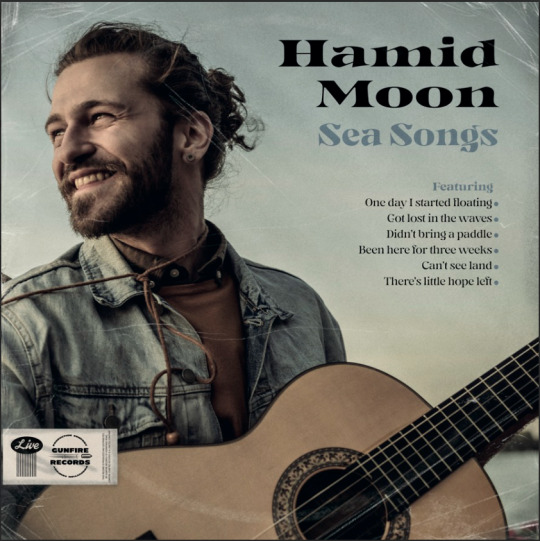
Hamid Moon: Sea Songs. Song titles: One day I started floating/Got lost in the waves/Didn't bring a paddle/Been here for three weeks/Can't see land/There's little hope left
Colors: Soft blue, tan, brown, burnt orange. Aziraphale, Aziraphale, Aziraphale, secret Crowley?
Theme: Lost
Okay, the first one involved being sleepy, the second, being lost. Where are you going, Mel? Stay with me.
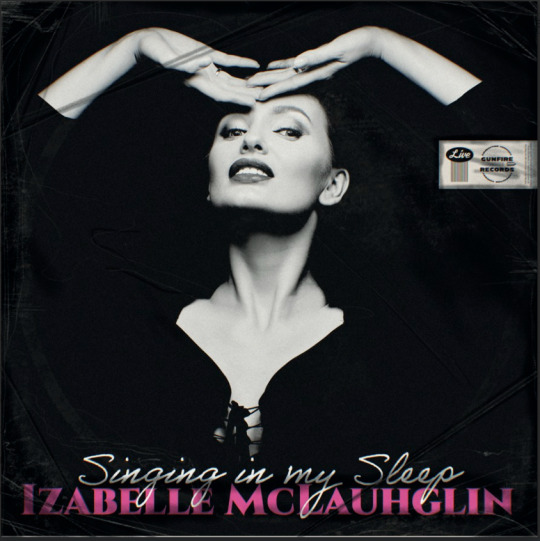
Izabelle McLaughlin: Singing in My Sleep. No song titles.
Colors: Black, gray, neon pink. Crowley, shades of gray, Heavenly miracles?
Theme: Sleepy.
Wasn't someone singing in their sleep? We assume Gabriel, but no name is actually said, and I'm not so sure. Don't ask me who it is, I don't know yet, but I don't think it's Gabriel. So, a second album featuring sleepy. Big whoop, right?
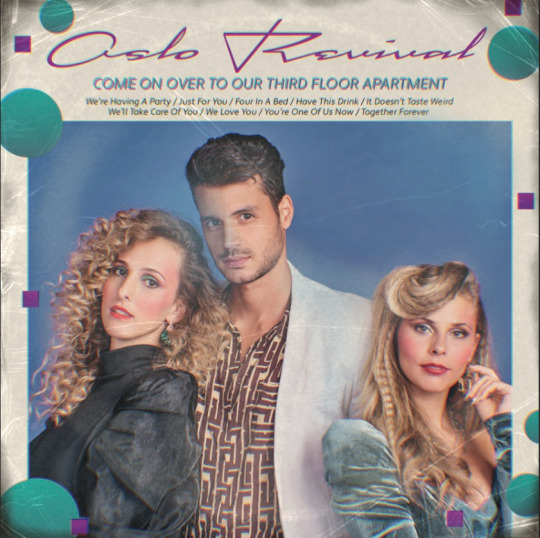
Oslo Revival: Come on Over to Our Third Floor Apartment. Song titles: We're having a party/Just for you/Four in a bed/Have this drink/It doesn't taste weird/We'll take care of you/We love you/You're one of us now/Together forever.
Colors: Black, white, gray, red, yellow, green, blue, auburn, purple, pink. Crowley, Heaven, shades of gray, Crowley, Crowley, Hell, Aziraphale, Crowley, Hellish miracles, Heavenly miracles?
Theme: Drugged, lost?
What the sweet Frances MacDormand??? What kind of song titles are these? Someone came up with these, deliberately, and then they got put in the Amazon extras. Why??
And Mel, what have you put in my drink? Where are you taking me?
Onward:

Raga Koboj: Earth, Swallow Me Whole. Song titles: Why can't I just stay in bed?/Sighing loudly/No one's going to lunch/I'm hungry but I don't want to eat alone/I wonder what's on the menu today/Probably something mediocre/I'm tired/It's Friday/I wish it would end
Colors: Black, blue. Crowley, Aziraphale?
Theme: Sleepy, hungry
Again, what the heck is going on here? Although now we have some overlap between sleepy/hungry. Still, though, what does this have to do with Good Omens??
There's more:
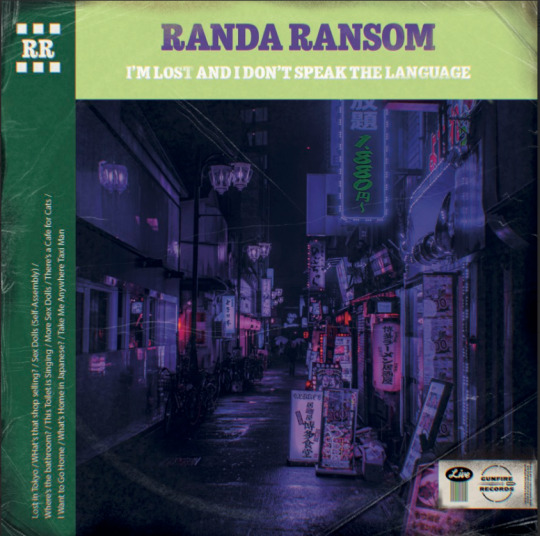
Randa Ransom: I'm Lost and I Don't Speak the Language. Song titles: Lost in Tokyo/What's that shop selling?/Sex dolls (self-assembly)/Where's the bathroom?/This toilet is singing/More sex dolls/There's a cafe for cats/I want to go home/What's home in Japanese?/Take me anywhere, taxi man.
Colors: Green, purple, red, neon pink. Hell, hellish miracles, Crowley, God?
Theme: Lost.
So here's another album involving being lost. Not hungry or sleepy. I'm still super confused about what's going on here. You? Great, let's keep going.
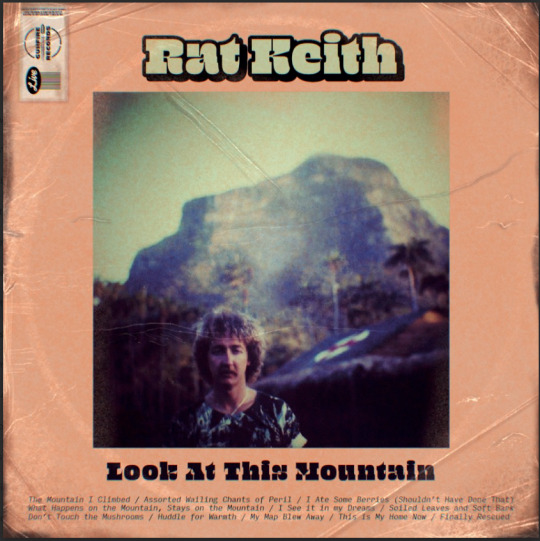
Rat Keith: Look at This Mountain. Song titles: The Mountain I Climbed/Assorted Wailing Chants of Peril/I Ate Some Berries (Shouldn't Have Done That)/What Happens on the Mountain, Stays on the Mountain/I See it in My Dreams/Soiled Leaves and Soft Bark/Don't Touch the Mushrooms/Huddle for Warmth/My Map Blew Away/This is My Home Now/Finally Rescued
Colors: Black, burnt orange, blue, purple. Crowley, secret Crowley, Aziraphale, Hellish miracles?
Theme: Drugged, lost, hungry.
With me so far? Good, me neither. One more:

Rehan Yu: Neon Dreams 2.0. Song Titles: Late Night Madness/Last Orders/Stumbling/The Night Tube/Falling Asleep/Waking Up in Vauxhall/The Night Tube (remix)/Giving Up at Wood Gree/Walking Alone/I Dropped My Phone/Shitty Kebab/Restless Sleep in a Bush
Colors: Black, white, red, blue, purple, neon pink. Crowley, Heaven, Crowley, Aziraphale, Hellish miracles, Heavenly miracles?
Theme: Sleepy, hungry, drugged (drunk), lost. There's the whole thing connecting all the other threads.
Did I say "connecting??" What the hell could the connection here possibly be?
The only thing I can think of right now is my theory about the missing scenes -- that there should be scenes opposite The Resurrectionists scenes, but they're missing. It's the only spot I can think of where someone -- Crowley -- gets drugged. So given the missing scenes should be parallels, Crowley drugs someone? Fucking WHO??
Whoever it is they've got in the bookstore, who isn't "you know who" any longer and was singing in his sleep? In both those instances, we assume Crowley and Aziraphale are talking about Gabriel, but I don't think so.
Is it Jesus 2.0? Except I suspect Nina is Jesus 2.0. Is it fucking GOD?? I know God is voiced by a woman, but let's let go of genders for a moment and remember God is often thought of and described in Christian mythology as not really any one gender. And given the Izabelle McLaughlin album, black and pink, titled "Singing in My Sleep," I think it might indeed be God. Though how Crowley might have drugged Her, I have zero idea. Does it have something to do with the 25 Lazarii miracle? Still, how could even that potent a miracle fuck with GOD?? What about someone else? Could it be Adam? Why would they kidnap Adam and drug him? Is it someone else ENTIRELY??
I will add that while I have black interpreted as a Crowley color here, it also seems to represent hiding and secrets throughout the show. And there is more than one person in the show with a black outfit and a pink accent piece. I feel like God's floating around somewhere, more present than we think.
I've also got purple interpreted as Hellish miracles -- but Gabriel's eyes are purple, too. Are those two things different shades of purple? I'm not even sure. It's kind of hard to tell. So take my color interpretations with a hefty grain of salt.
And frankly, I could be dead ass wrong about ALL of this. I could be overlapping categories that I'm putting the albums into -- sleepy, hungry, drugged, lost; only Neon Dreams 2.0 fits all four. That inspired me to put all these albums in the same category, but it's possible they don't go together. Maybe the sleepy albums all go in one category, and the lost albums all go in another. I don't know for sure. Perhaps they spider out from Neon Dreams 2.0? I don't know what that would mean.
But I feel like I'm onto SOMETHING. I'm going to keep poking until I find out exactly what.
#good omens#good omens 2#good omens meta#good omens analysis#ineffable mystery#good omens fan theory#is it a theory if I don't know what the hell I'm looking at?#good omens maggie#the small back room#maggie's shop
39 notes
·
View notes
Text
20 Questions: Writing Edition
tagged by @ghostoffuturespast and tagging @lemonlilactea and @clockworkvenus (no pressure!) and anyone else who happens to be reading and wants to play :3
How many works do you have on ao3?
20! Which feels sort of insane. It feels like I've both written much less and a lot more.
What's your total ao3 word count?
155,384 which feels absurdly low. 285,984 is the word count in one (1) of my Scrivener projects so there's a lot which is not making it to the end of the pipeline.
What are your top 5 fics by kudos?
no promises
the damn things overlap
An Exchange
everything where it belongs
come back wrong
What fandom do you write for?
Mostly Cyberpunk although in the previous question you can see that I've gotten more attention in various other video game fandoms I've written for (fe3h/pathologic 2/Prey (2017)). I've also written plenty of fics that have never seen the light of day for Outer Worlds and Dragon Age 2 and a little bit of BG3.
Do you respond to comments? Why or why not?
Yes! Unless the comment is weird. Sometimes it takes me a while because time isn't real, but I always appreciate someone taking the time to actually leave one of any length because I know how much effort it takes. As a long-time lurker I know it's tough to make that jump from reading something to interacting with the creator. It's always nice to feel like I'm not just chucking my passion project into the void and I hope folks aren't too disappointed if it takes me a while to work up the courage to reply. Sometimes I like to keep things in my inbox for a while so I can enjoy them. :3
What's the fic you wrote with the angstiest ending?
Hard to pick between you and me and the devil makes three but that one is so short it doesn't feel as much as a punch to me as a pair of open graves. Even though Valentine is being cared for by the people who love her most, it's extremely hard to think about the fact she's slowly losing her mind and doesn't want to admit it, and the fact that she was actively concealing the fact from Goro and to some extent herself. Something about her surviving everything and having a few good years and then declining quickly because of the damage from the Relic while Johnny himself is doing fine... T-T I'm fine, actually.
What's the fic you wrote with the happiest ending?
everything where it belongs is 100% feel good smut and I guess has a few happy endings. not a lot of competition with all the cyberpunk fics though lol
Do you get hate on fics?
I've gotten a few odd comments which are sort of back-handed, but not too bad and I like to assume good intentions. By far the worst is when someone reblogs my writing on tumblr and misgenders a character. Makes me yearn to pack it in and move back into the woods.
Do you write smut?
Oh you betcha. If I want the dynamics that really get me going, especially with a nonbinary and/or trans character I gotta write it myself. Dutifully contributing my work to the sparse "Other" category on ao3 like a good soldier.
Do you write crossovers?
I haven't recently but I have in the past, mostly in my youth. It's hard to stitch two disparate worlds together, at least with the stuff that I like. I did semi-recently think about Viago Dragon Age in the cyberpunk universe. I think he'd love having access to spreadsheet software and industrial grade stimulants.
Have you ever had a fic stolen?
I mean probably scraped from ao3, but whatever. Once you put something on the internet you never know where it'll end up and I'm at peace with that. Nobody is getting any more recognition off my work than I am lol.
Have you ever had a fic translated?
Nope! Think that'd be pretty neat though.
Have you ever co-written a fic before?
Yes! I've written a fic with @slayerdurge with our V's, which was a blast. In the distant past (i.e. middle school) I've also written a fair number of fics with my friends which can be chaotic but also fun.
What's your all-time favorite ship?
I'm not really a person with all-time favorites, things come and go with different strengths. After having spent some time writing a lot of datv fic for my own gratification and having fun with a friend, I will say I'm really glad to get back to Valentine/Goro. dog4dog 4ever.
What's the WIP you want to finish but doubt you ever will?
All of them. I have so many! My one hope is that I can finish at least the damn things overlap even if I never get fully around to writing all the other stuff I'd like to write.
What are your writing strengths?
I like to think I can keep a story moving, and by far my favorite step of writing is editing. Taking a wild thorny draft and slicing and cutting and rearranging until it's tight and has good mouthfeel. I do also think I do a good job of keeping canonical characters in character, or at least once I've had some time with them, making their changes make sense according to what's happened to them and the context they're in.
What are your writing weaknesses?
Plotting, organizing, executive function. I struggle to write things linearly, I've never written an outline I didn't wildly deviate from once I actually got down to it, and I can't tell you the number of times I've done some skimming over early chapters to make sure I've kept things consistent only to find I'm trying to do something I already did and take it out. Writing with ADHD can be frustrating and sometimes I'm at peace with it and sometimes (lately) it makes me want to wail and gnash my teeth– why doesn't my brain just work? Why can't I fucking remember?? Why do I remember feeling the warm glow of an idea and not the idea itself? It's gone forever!
Thoughts on writing dialogue in another language in a fic?
I generally avoid it, because I don't have the skill or resources to write dialogue in other languages naturally. If the POV character knows the language I will just write the gist of what is said in another language in English and note what language they're speaking (if relevant) and if the POV character doesn't know, then they just note someone is talking in another language along with what they do notice about tone & volume and similar. I feel like often the best I can do is try to make a bit of the underlying language come through in the English translation but if I can't do that then I can at least get out of the way and not bungle the original language.
Favorite fic you've ever written?
My darling thread-safe. I've said it before and I'll say it again, it's probably some of my best writing, it's a punch to the gut, and yet I still couldn't resist putting a bit of hope into it. It's got Valentine and Goro on opposite sides, and yet still stupidly in love and clinging to each other. It's got all of Valentine's fractured pieces, including Johnny. It's about everyone finally having to face the options in front of them and wishing they could go back and do things differently, but they just have to keep moving forward. It's about Johnny's loved ones helping him stay free, and Valentine's loved ones making her prison tolerable. Agh!
8 notes
·
View notes
Text

———
This was a very silly goofy post I enjoyed but it also sparked genuine curiosity: how accurate is this? I’m a data hound, so I did some fact checking. Please be aware I am by no means an expert and this was simply a result of some cursory investigating and inputting stuff into a calculator.
For RTD, I took it to mean any episode title that was singular. Only eight out of the sixty episodes of RTD’s run have one word titles, with six having two syllables (Dalek, Doomsday, Gridlock, 42, Utopia, and Midnight) and the other two being monosyllabic (Rose and Blink). That’s roughly 13% of his episodes. Definitely a trend but he was actually quite creative with his titles. Here’s some other fun statistical stuff: the most popular words in episode titles appear to be ‘dead’ (The Unquiet Dead, Forest of the Dead and Planet of The Dead), ‘planet’ (Impossible Planet, Planet of the Ood, Planet of the Dead) and ‘time’ (Last of the Time Lords, End of Time Part 1 and End of Time Part 2) occurring at about 5% each, with ‘earth’ and ‘doctor’ occurring twice each respectively.
For Moffat, I went a little more broad, considering any episode that used the naming convention ‘of’/‘of the’ or featured ‘doctor’ in any capacity. Out of the eighty-four episodes in his run, twenty six filled the criteria, that’s about 31%. Eighteen adhered to the ‘of’ requirement (Victory of the Daleks, The Time of Angels, The Vampires of Venice, Day of the Moon, Curse of the Black Spot, The Wedding of River Song, Asylum of the Daleks, The Power of Three, The Bells of Saint John, The Rings of Akhaten, Journey to the Center of the TARDIS, Robot of Sherwood, In the Forest of the Night, The Husbands of River Song, The Pyramid at the End of the World, The Lie of the Land, The Empress of Mars, and The Eaters of Light), four contained the word ‘doctor’ (Vincent and the Doctor, The Doctor’s Wife, The Doctor, the Widow and the Wardrobe, and The Doctor Falls), and four fit into both categories (The Name of the Doctor, The Day of the Doctor, The Time of the Doctor and The Return of Doctor Mysterio; it’s funny once you realize that Name, Day and Time were all released sequentially). The claim is thereby substantiated, the man loves his ‘of’s’.
Chibnall’s criteria was difficult to discern but I decided on anything that contained the name of a Who monster classic or otherwise, was a part, or similarly used ‘of’/‘of the’. My findings were quite interesting as there was bunch of overlap between my selected categories. As a whole, out of the thirty-one episodes in Chibnall’s run, eighteen fit the criteria. That’s an overwhelming 58%, so it is most definitely correct assumption. In terms of part episodes, there were eight as there are two proper parted episodes (Spyfall, Part 1 and Spyfall, Part 2) and the serialized six-episode Flux series. Thirteen episodes contain ‘of’/‘of the’ with six exclusively using ‘of’/‘of the’ (The Demons of the Punjab, The Battle of Ranskoor Av Kolos, Nikola Tesla’s Night of Terror, The Haunting of Villa Diodati, Chapter Five: Survivors of the Flux, Power of The Doctor). This is where it gets interesting, as the remaining seven episodes containing ‘of’ are all the Who monster episodes (Ascension of the Cybermen, Revolution of the Daleks, Fugitive of the Judoon, Chapter Two: War of the Sontarans, Chapter Four: Village of the Angels, Eve of the Daleks, Legend of the Sea Devils). It would appear that Chibnall is an equal fiend for ‘of’s’, especially considering the monsters. So, very on brand for classic who naming conventions as well.
To conclude, it was a largely factual silly goofy post (props to @fanonical) and I enjoyed my little data collection exercise.
#doctor who#dw#dr who#steven moffat#rtd#chris chibnall#new who#episode data#i don’t know what research demon possessed me but here we are#i am normally not interested in statistics#i am not a math guy until it’s something i am interested in#please appreciate this rabbit hole i went down
61 notes
·
View notes
Text
A Brief Introduction to Gender in Slavic Languages
I dedicate this post to all non-binary people in general, and non-binary people whose native language is a Slavic language in particular. I love you and support you!
I've seen several versions of the following meme in the past few months:
"Non-binary in [insert a Slavic language] is [word for "non-binary" in masculine form] or [word for "non-binary" in feminine form], depending on the person's gender."
And I cannot express how much I hate that lame fucking thing!!!
In case you didn't get it, the message is that even if people come up with words like "non-binary", it is not possible to actually use them without conforming to a gender binary anyway.
And yeah, it's not always shared with malicious intent. I have seen it used as an example of very real struggles non-binary people need to face, how they're constantly forced into cathegories that don't fit them, a kind of "we are fucked by languages, aren't we" dark humour thing etc.
Unfortunately, more often than not, the underlying sentiment seems to be that you can make up fancy words, but you can't escape the reality that you're either a boy or a girl.
Even though it's glaringly false, who cares, right?
And I mean both the small-minded belief and the meme itself.
I genuinely believe that it was originally written (1) by a person whose first language is English and who doesn't have a good feel of how gendered languages work, and (2) about a non-Slavic language, maybe Spanish or French? Oh, and also (3) a person who is unkind, or stupid, or both.
Anyway, in celebration of Pride Month, here is a crash course on gender in Slavic languages for all the language nerds and gender nerds, with love.
Lesson 1 - How Do Gendered Languages Work?
In a gendered language, we can divide all words into three groups: (A) those that have no gender at all, (B) those that have one fixed gender, and (C) those that can take any gender and therefore have multiple forms, one for each gender.
Group A consists of words like prepositions, conjunctions, adverbs, and many verb forms. They and only they are truly genderless, in the grammatical sense. The category of gender doesn't apply to them at all, the same way grammatical tense does not apply to nouns.
Group B is basically all the nouns. Every noun has a gender that is its fixed grammatical property. When you check a noun in a dictionary, it will tell you what gender this specific noun is.
Group C can be defined as "words that are somehow grammatically linked to the noun". Like adjectives and some verb forms. They always "borrow" the gender of the noun they are describing. This means that while they don't have their own gender, they always exist in a gendered form.
Lesson 2 - Grammatical Genders in Slavic Languages
For singular forms, there are three grammatical genders: masculine, feminine, and neuter. Yes, let me repeat it: THREE genders, including NEUTER.
This is true for every Slavic language I am aware of. Not all of them use neuter gender to the same degree; some pretty much replaced it with masculine, but at least in theory, it is always there.
(I am not getting into plurals here. For many reasons.)
That means that every singular noun is either masculine, feminine, or neuter. It also means that every adjective has three singular forms - masculine, feminine and neuter, and when you want to use an adjective in a sentence or a phrase, you need to pick the form that matches the noun it's meant to refer to.
Lesson 3 - Grammatical "Gender" vs. Actual Gender
(This is the part that I've noticed people whose native language isn't grammatically gendered - like English - struggle with a lot, and easily misunderstand.)
There is a significant overlap between grammatical gender and biological/semantic gender but they are NOT the same thing.
Yes, for living beings, especially people, grammatical gender aligns with their actual gender. Words like "man", "boy", "father", "brother" etc. are grammatically masculine. "Woman", "girl", "mother", "sister" etc. are grammatically feminine. Also, every male name is grammatically masculine, and every female name is grammatically feminine.
However, there are words whose grammatical gender diverges from the actual gender of the person they describe.
For instance, in my mother tongue, the word for "human" is grammatically masculine, and the word for "person" is grammatically feminine; however, semantically both are gender-neutral, can be used for anybody, and it is in fact very natural to use them for anybody.
Let's look at a sentence that translates to "My bother is a very calm and patient person". The word "my" will have a masculine form, because it refers directly to "brother", which is a grammatically masculine word. But both "calm" and "patient" will take feminine forms because they refer to the word "person", which is grammatically feminine.
We are talking about a man, but proper grammar requires us to use feminine forms. It is not jarring. It is not "woke". It is a normal way to talk and has always been.
We could change the sentence to "my sister is a very calm and patient human" (it sounds a bit odd in English for some reason?) and then we would be in a reversed situation - "my" will be feminine, but "calm" and "patient" will be masculine. So now we are using masculine forms to describe a woman, and again, it is 100% normal and common.
In both cases, even though we use words whose grammatical gender diverges from the actual gender of the person we are talking about, we are not misgendering anyone.
And that's because grammatical gender isn't actually a gender. It isn't even called that in my mother tongue, but rather by a word that more accurately translates to "kind" or "type". It's just a grammatical category.
It's a topic for a whole other post, but this is especially true for inanimate objects. I sometimes feel that native English speakers have a hard time understanding that just because, say, "table" is grammatically masculine, and we use "he" instead of "it", we do not actually perceive it as a male or attribute it with some masculine qualities... We really don't.
OK, so about that meme...
Let me quote it again:
"Non-binary in [insert a Slavic language] is [word for "non-binary" in masculine form] or [word for "non-binary" in feminine form], depending on the person's gender."
Do you see where the issue is?
Yes, the most infuriating and glaringly obvious mistake is omitting the neuter gender.
Even though I still suspect that the meme might have been originally about a language like Spanish or French, which do indeed have only two grammatical genders, and yes, jokes and memes get "adapted" for other countries/languages/cultures all the time and it's not uncommon for it to be really forced and just not work, I still cannot excuse the level of wilful ignorance necessary to make the Slavic version of this specific meme and still conveniently only mention two genders.
If we correct it:
"Non-binary in [insert a Slavic language] is [word for "non-binary" in masculine form] or [word for "non-binary" in feminine form], or [word for "non-binary" in neuter form], depending on the person's gender."
it's suddenly not that "funny" anymore, is it?
But it gets even weaker when the more subtle stuff enters the chat. Let me remind you that in gendered languages, gender is a plain grammatical category.
"Depending on the person's gender" sounds dramatic and may not be technically wrong, but it actually should be "depending on the noun's gender".
So if we correct it again
"Non-binary in [insert a Slavic language] is [word for "non-binary" in masculine form] or [word for "non-binary" in feminine form], or [word for "non-binary" in neuter form], depending on the person's noun's gender."
there's nothing left that you can poke fun at because this is how EVERY ADJECTIVE WORKS!
If your language isn't gendered, it might seem like some kind of paradox that the word "non-binary" exists in masculine and feminine forms, or that it somehow undermines the meaning of the word "non-binary". But it really isn't and doesn't. Every adjective has masculine, feminine, and neuter forms. Every single one. Not just "non-binary", but "masculine" and "feminine" too. All of them do.
Adjectives don't have their own gender and always take the gender of the noun they refer to, regardless of their meaning. Take that, non-binary people!
Also, please note that when we replace the word "person" with a more accurate word "noun", the stupid joke doesn't even work for French or Spanish or other languages with only two genders? Because even if you can't say "I am non-binary" without being forced into a gender binary (which, again, in Slavic languages, you totally can thanks to neuter gender), you can always say "I am a non-binary person" and you are no longer forced to misgender yourself.
Thank you for reading.
#linguistics#languages#slavic languages#gendered languages#gender in language#non binary#enby#genderqueer#overcomplicated review of a bed meme
11 notes
·
View notes
Text
QSMP Awards 2024 Summarized
-The audio was scuffed for the first half. I don't mean a little crispy. I don't mean with a slight echo. It was fucked in every way imaginable. The audio sounded like it was going through a blender. Then it kept getting too loud, then too quiet (so much so we couldn't hear), all while being way too crispy. Charlie Slimecicle monologued to the audience while the team was trying to fix it but since the audio was both too crispy and too quiet we couldn't actually understand anything he was saying. This carried on for about 7 minutes with him holding two microphones, neither of which was working, before the stream crashed (again)
-All the staff are apparently Cucurucho, with one of them being a "main Cucurucho"
-Missa wore a "Quackity my beloved" shirt. I could not explain to you what the blazer over it was supposed to be.
-Everyone else at the ceremony was shown through discord call. I'm convinced Charlie has never seen German or Lenay's faces cause he did not know it was them until Quackity said their names
-The screen was supposed to switch between showing all the people on the discord and it kept switching between the same four people. If I have to hear Q, Charlie and Missa chant "Foolish" or "Pol" ever again-
-Mariana showed up and Charlie immediately went into bitter ex mode. He also hit on Mariana. Multiple times.
-We got a patented Ironmouse "coño" and chat lost their shit over Luzu existing, as expected
-Mariana looked like Michael Jackson, Bad's background could've been the set of Breaking Bad, Roier had a ski mask, lots of people learned what Lenay, German and Vegetta's looked like for the first time, and Mike had a kawaii filter
-Somehow Bad didn't even get nominated for Best Cucurucho Jumpscare, showing that even non-red carpet events can produce award snubs (congrats to Bagi!)
-Though I yearned for Maximus getting nominated for his Eh Vegetta prank, we all knew the win had to go to Vegetta for the mines
-The audio eventually became bearable but the echo never fully left. At some point there were like three or four overlaps of Vegetta giving his acceptance speech
-Acau won for Best Death from getting killed by an enderman (in my heart Foolish's accidental death by Pomme's sniper that got him eliminated from the elections won, but we did get Quackity dying to a fly as a nom so I feel complete. Also congrats to Acau!)
-The Qsmp shop is officially open! We got eggie merch :]
-Quackity forgot to roll clips for the Best Purgatory 2 Moment nominees and almost read out the winner before we got the montage (Wuant won! It was the clip of him being told he lost and he accidentally did a flip. They weren't able to get the acceptance speech on stream so we saw it from Quackity's phone)
-Funniest QSMP Moment nominees were all fucking hilarious, its hard to pick just one but Maxo winning for when he respawned after a lore-heavy moment in Pierre's bed to his own moans being remixed into a song absolutely deserved the win
-Saddest QSMP Moment was unnecessary and the admins will be hearing from my lawyers for making me relive Dapper's first lost life, Dia de los Muertos and the end of Purgatory 1 (Jaiden and Roier saying bye to Bobby won, Roier changed his screen to black and white and held up what looked like a mini Cucurucho being used as a cross)
-Best QSMP Original Song was played prematurely when the category was Best Language Exchange, and we got a spoiler for the winner (YD and Hugo's exchange won and YD's audio was muted so we just saw her Vtuber model getting excited)
-The aforementioned Best Qsmp Original Song had Gordinho Gostosinho looping aggressively over Charlie singing the Juanaflippa song, which I hope to god gets clipped cause it was hilarious (I'm glad the Roier and Cucurucho rap got nominated). Charlie was very confused why they had him announce his own win.
-Best PVP unsurprisingly went to Etoiles for his colosseum Code fight, after all he is the Best🔥 (the other noms were great too, we had Philza vs Tubbo in Purgatory, Bad and Maxo eliminating El Quackity from the elections, and a cute sparring session between Pac and Richas)
-Best Qsmp Fails went to Fit for that time Pac's internet cut out during their date (of course he bragged about his Brasilian boyfriend after learning he won for best loser)(also if it was up to me Quackity's fly deaths would've been added to this category just sayin')
-The audio problems were revealed to have been roleplay the entire time. Yep. All part of the lore.
-Speaking of, most of the winners who were in the discord call could not be heard so they had to give speeches through Quackity holding his phone up to the mic
-Best Roleplayer went to Roier for his Doied arc (the screen prematurely showed him before they could read the announcement, and his speech was him kissing the camera)
-Worst Server House went to Mariana accompanied with the classic clip of him reacting to the admins roasting his started base; Mariana was part of the discord call but left at some point so he couldn't give a speech, to which Charlie jumped on the opportunity to roast his absence like a shark smelling blood (they rightfully nominated Quackity for his clip of Acau reacting to his failure of a starter house, and apparently Carre's base is just his bed on a dirt plot)
-Most Iconic Clip went to Pac for stealing the Qsmp Logo (the other lovely noms included Foolish and co. accidentally closing their house door after a creeper came in an attempt to shut it out, and Tina reacting to a mob giving Felps a blowjob)
-The Most Bankrupt Islander went to Niki for being broke, we stan (during the nom montage we got a passa tudo mention)
-The Creator Who Spent the Most Time on the Server Award went to Bad, which was shocking to no one, although they did use his Barbie Girl clip for the nom montage (they also used Fit wearing a wig for his clip)
-The Qsmp cake for the one year anniversary had the text "FELICIDADES ALBERTO". We do not know who Alberto is. Pol was losing it.
-Tubbo won for The Creator With the Most Deaths (106), while The Creator With Fewest Deaths went to Philza (he only had 1!). Philza was able to be heard through stream but the hosts didn't know this so they would hear him from Quackity's phone and repeat what he was saying even though we could hear him
-Everytime the camera cut back to the hosts Charlie, Quackity and Missa had more cake on their faces
-Most Distance Traveled (in Minecraft) went to Etoiles (6,000+ km jfc)
-Creator With the Most Mob Kills went to Pierre (162,960 mob kills. what the fuck.)
-They accidentally read the award for Creator With the Most Damage Taken (Foolish) during the Best Builder announcement, confusing the shit out of everyone, especially cause the screen showed Mike instead of Foolish. I am still unclear who won Best Builder
-Creator With the Most Blocks Placed went to Mike!!! (MIKE WIN VAMBORAAAAAAAAAAA🇧🇷🇧🇷🇧🇷)
-We had to uncomfortably sit through Missa feeding Charlie cake (and just Charlie in general)
-There was an In Memorium segment of the passed eggs (Quackity shat on a grieiving Charlie for Flippa only lasting 11 days, but in Charlie's words, "to you it was 11 days; to her it was a lifetime"). Charlie commentated and had nothing to say about Trump because he didn't know jack shit about Trump (though he did make a wall joke which is exactly what Maxo would have wanted godbless🙏)
-The stream ended with the discord people saying goodbye, while Roier was holding up the mini Cucuruchos and didn't move the entire time. I know he wasn't frozen because he blinked.
-Maxo sent in his acceptance speech video last minute and Quackity hyped it up as a mysterious final entry but Charlie guessed it was Maxo and spoiled it on accident
-Speaking of, Maxo's entry was him walking around heaven looking for Trump </3
-Charlie gave a heartfelt speech about the people he met through the Qsmp, all while looking like ate out frosty the snowman <3. Missa simpy thanked Alberto (we still do not know who Alberto is)
-Tubbo wasn't present in the discord call because he thought him streaming meant he couldn't join. After the stream Quackity called and Tubbo realized he was allowed to join the whole time
-We ended on a montage of various moments, with a message of excitement looking forward to the next year!
And of course, here are the screenies I managed to nab of the hosts slowly deteriorating into cake
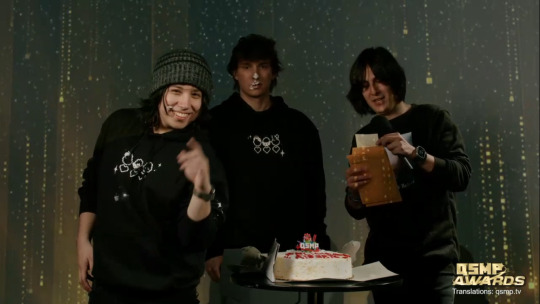
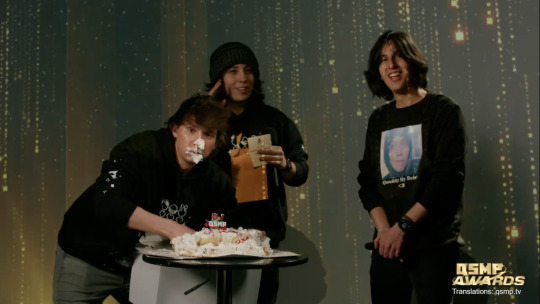
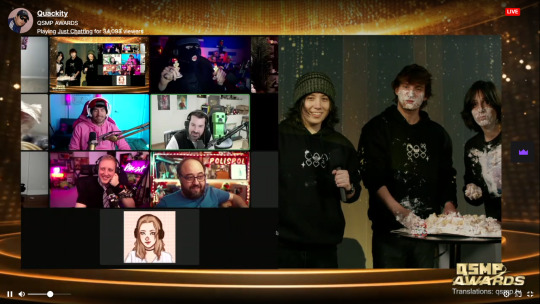


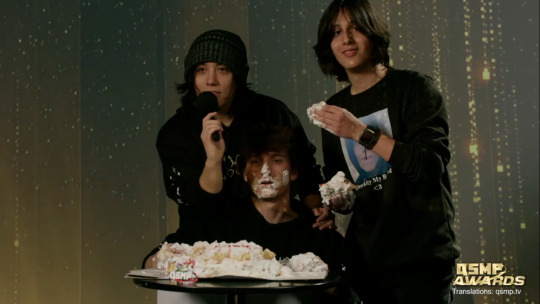
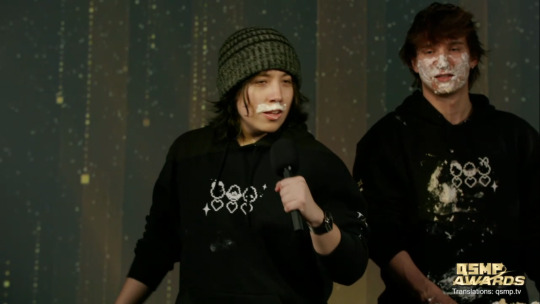
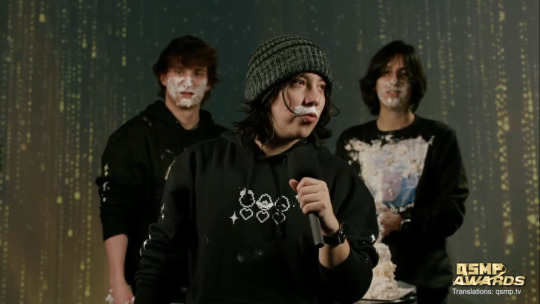
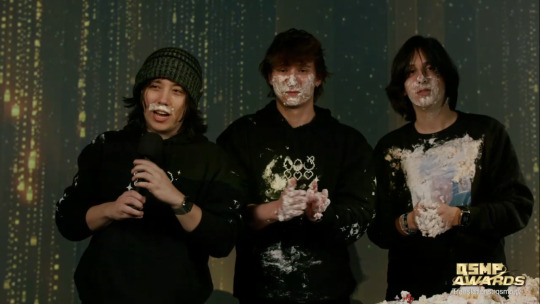
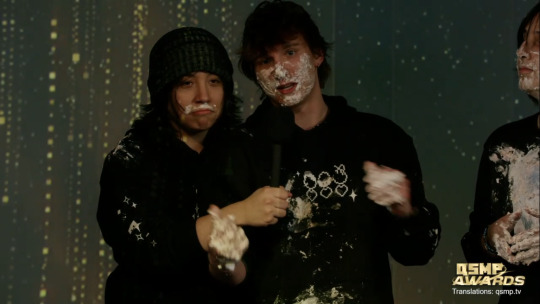
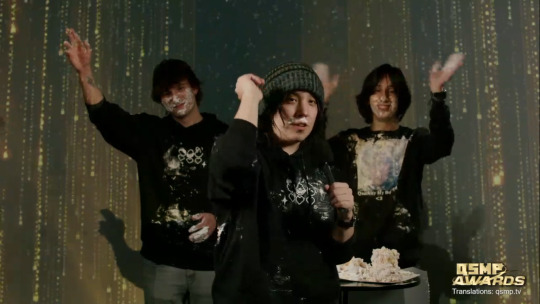
#this is how i return to regular posting#i say to myself in the mirror#anyway its been a month how yall doing#liveblogging#mcyt#qsmp#qsmp recap#qsmp awards
65 notes
·
View notes
Text
Well, it's the Olympics in the age of trans panic and I'm sure you can guess what that means. With that in mind, a few thoughts about gender and sport.
Okay, let's talk about the specific event that touched this off, Italy's Angela Carini abandoned a boxing match with Algeria's Imane Khelif after only 46 seconds, citing Khelif's strength and power. Some of the less reputable people in politics and media then began to speculate that she had some gender advantage despite having passed a gender and drug test which would have discovered something.
Look, let's get this out of the way at the start, Imane Khelif is a woman. She was born a girl and matured into a woman. She lives in and competes for a country where gender transition is illegal and there's no indication to any reasonable person that she's anything other than a woman who is very good at boxing. Perhaps she has some genetics that help her but, let's face it, every single athlete capable of competing at the Olympic level does; no one complained that Michael Phelp's low production of lactic acid was an unfair advantage! The only reason that there's any "controversy" at all is that people have this ingrained idea that women should NOT be too good at boxing.
And, ultimately, that's the biggest problem with this whole gender panic. There are three (count 'em, three) transgender athletes in the Olympics this year, Canada's Quinn (soccer), New Zealand's Laurel Hubbard (weightlifting), and the US's Chelsea Wolfe (BMX Freestyle - Reserve). Every other athlete in the Olympics was born in their assigned gender and has been tested as such in order to compete.
So why are people panicking about trans athletes? Simple, because their ideas about gender do not match the reality. Not every woman is physically smaller and weaker than every man, not every man has a hulking physique, and there is no clear dividing line between the testosterone levels of women and men. There's also racism at work, African and Middle Eastern women tend to have facial features associated with masculinity in the west while Asian men tend to have facial features associated with femininity in the west making it easy for white audiences without exposure to minorities to assume the worst.
Ultimately, though, the problem is this idea of a sharp gender binary as if men and women were two clearly different species with no overlap between them. Let's say this as clearly as possible: there is no way to define "woman" in a way that excludes all trans women and includes all cisgender women. There is simply too much overlap between men and women; biologically speaking, mammals in general have very small gender differences compared to other groups of species such as insects or certain groups of fish (look up the differences between male and female spiders or anglerfish sometime, THAT'S a gender binary).
What that means is that, no matter how you try to define "woman" or "man", you will always end up with a category that includes some people who every reasonable person would consider to be the opposite.
So here's the question I think we all need to answer before we go any further: what is the purpose of separating sports by gender? Is it so that inferior female athletes can get medals that would be denied to them by superior male athletes? Is it to reinforce our cultural gender norms? Is it another way to divide the competition for fairness like weight classes in boxing?
I suspect that different people have different answers to that question and, until we settle on a universal answer, athletes (who, by the way, are pretty much all outside of the averages for their age and gender by definition) are going to continue to be caught in the crossfire of one of the worst arguments to dominate our society.
#olympics#imane khelif#transgender#trans panic#gender#gender differences#olympic athletes#paris 2024
24 notes
·
View notes
Text

SPRING CLEANING ( PART 4 )
on the fourth day of spring cleaning my rp gave to me…
an open plots request and threads! if you have some outdated connections or plots that you’ve wanted to fill up, now is the time to start working on that! for this part there will be multiple tasks, but we recommend keeping track of any threads ( new or old ) that you have replied/started since APRIL 6.
TASK 1: OPEN PLOTS
everyone will have until JUNE 7, 2025 11:59PM EDT to post on dash their open plots using the hashtag lgc:openplots. for this to count as completed, the post must contain at LEAST 5 ( more is always encouraged ) open connections that would fit any of the categories ( eg. familial, friends, enemies, romantic ) and a short blurb ( 20+ words ) for each of the connections. ideally, it’s best to concentrate on the connections that you NEED the most for your muse or would help with character development. if you’ve already made an open plots post recently, you can go straight to submitting the form ( and if you want, reblog it for the people to see it ). make sure to keep this updated as often as possible since it will be necessary for the next task!
once you’ve posted your open plots, please submit the form below and send it via lgcpoints blog before JUNE 7, 2025 11:59PM EDT:
MUSE NAME ∙ SPRING CLEANING ( PART 4 – OPEN PLOTS ) - OPEN PLOTS: [ LINK ]
TASK 2: CONNECTIONS & THREADS
once enough people have done the first task, please look through the hashtag/dash for any connections that you would be willing to take. plot with each other for ideas on how to expand on the idea and when you’re ready, start a thread around it!
this is where keeping track of multiple threads is important because as you will see below, you will be expected to fill the form out based on which thread fits which requirement. you are not required to fill out ALL of the requirements, but at least THREE of them should be met. also, threads cannot be overlapped, which means that if you have a thread that can meet two of the requirements ( eg. friendship thread + a thread a muse you’ve never interacted before ) OR if the thread overlaps with two of the events/missions ( eg. crystallis mission’s sugar-holic promo req with continuing a past thread ), choose only ONE. all of the threads must be between TWO muses ( so unfortunately group threads will not be allowed at this time )!
in terms of replies, it is required that the threads submitted have more than 4 replies ( 2 posts per each mun, 8 lines each ) but it is encouraged to go for more and to focus more on the character development. the exception to this is the COMPLETED THREAD req, which asks for a minimum of 8 replies ( 4 posts per mun ) for it to be counted.
here is the list of prompt requirements ( as a reminder, you only need to meet at least THREE ):
a thread with a muse you’ve never interacted before
a completed thread ( post must have AT LEAST 8 replies; 4 posts per mun. thread must have started on or after APRIL 6 )
a thread taken from an open plot ( doesn’t matter category )
a friendship thread ( must be from an open plot )
a family thread ( must be from an open plot )
an enemy thread ( must be from an open plot )
a romantic thread ( must be from an open plot )
a thread with a muse from a different career path than yours
a past thread that was started ( ooc ) between JANUARY 4-APRIL 5 and was continued for an additional 4 replies ( 2 posts per mun, minimum 8 lines )
when you’re ready, please submit the form below and send it via lgcpoints blog before JUNE 21, 2025 11:59PM EDT:
MUSE NAME ∙ SPRING CLEANING ( PART 4 – THREADS ) - PROMPT #: list which requirement the thread fulfills [ THREAD LINK ] **keep copying this line to match with how many reqs have been completed **
8 notes
·
View notes
Note
You’ve made a few silly posts about your agent having to deal with your genre-hopping body of work and I wanted to ask on a more serious note if that’s been an issue at all. I and do everything from literary short stories to YA fantasy to thrillers to experimental horror, and I’m aware that a lot of agents and publishers discourage working in so many genres; it’s better for marketing to have Your Thing. And plenty of writers use pen names for different genres, but I was just curious about your opinion as someone who doesn’t do that and who publishes several genres under the same name.
It hasn't been an issue with my agent, but it's something she knew about me going in. When we had our first call and she offered representation, that was one of my key questions: she's a children's books agent, but I write adult books as well as YA; would she be willing/able to represent my adult books as well, or would I need to find another agent to do that? Although she doesn't typically represent adult books, she was willing to do so for an existing client, and has agency colleagues she can consult for guidance. (Because, obviously, as a children's books specialist she doesn't have as many contacts in the world of adult books, or as much of an idea who to submit to.)
Having said that, we were on sub with The Wolf and His King for eighteen months. Would we have sold it more quickly if she were an adult agent, with the contacts and experience to go with that? I don't know. Quite possibly not -- the editor who ended up buying it, Bethan Morgan at Gollancz, wasn't at Gollancz when we went on sub. When we first approached her (after I'd met her by chance at a friend's book launch), she was working at another publisher in another genre, and asked us to hold on and submit to her in a few months because she was moving somewhere that might be a viable home for the book. And then we accidentally sold three books instead of just the one we were trying to sell!
I think there are pros and cons of using different names. I sometimes wish I published my academic work under a different name to my fiction, but it's slightly too late for that now. I do have some projects, such as the paranormal postgrads series, that I intend to use a different name for if they're published -- not secretly (given that I've posted about them a fair bit), but just to provide a degree of separation from my academic work in particular, especially given the overlap of my characters' research with my own. This would also provide more separation from my YA work, which I think would be valuable for these books. It's a shame perhaps not to have that separation between my YA and adult books already, but that's how things have worked out.
I have so far only sold in two genres/categories: YA dystopian/thrillers, and adult fantasy. I don't know what other barriers and challenges I might face if I branch out into more areas than that. However, a major advantage of writing in multiple categories and genres is that, if you're a fast enough writer to be producing more than one book a year, you can publish in multiple categories at once without cannibalising your own audience and without running into non-compete issues.
The main challenge my agent faces is that every time she turns her back I've run off and written something else I wasn't supposed to be writing (because I write very fast), and that, crucially, many of the ideas I come up with are not remotely marketable. I have discussed with her several ideas that, while I love them enough that I'll probably write them eventually, we've both acknowledged are extremely unlikely to ever sell, at all, because the audience is just too small. She's open to the possibility that I might move to being a hybrid author in future and self publish some of these niche books alongside more conventionally marketable trad pub things, but that's very much only an idea at this stage, since nothing is anywhere near being ready for that.
Anyway, basically, my agent is fine with it, but that doesn't necessarily mean she can sell everything I throw at her, or that I'm expecting her to.
#some people add a middle initial for disambiguation and i would do this if i had a middle initial#however finn is in fact my second name and i don't use my first#and i am contemplating swapping them and adding a new middle name. which i have not chosen yet#so that's a slight barrier. i would have to *pick* a middle initial#answered#anon good sir
14 notes
·
View notes
Note
so tell us about velothi philosophy :3c how does it differ, to say, its imperial counterparts? how has it changed across time?
Where to start!! Going to try my hardest to produce a semi-coherent answer here lol
quick note before i get into it— due to the nature of religion in the Elder Scrolls, i’m going to treat theology and philosophy as more or less the same discipline. there will obviously still be some discussions which fall more squarely into one field or the other, but in a world where ‘gods’ are demonstrably real and regularly involving themselves with the affairs of mortals, there’s going to be a great deal more overlap than there is irl.
with that out of the way, i’ll limit my discussion to three main areas of philosophy in which Velothi attitudes differ the most from their Imperial counterparts; (1) the determinism/free will debate, (2) notions of faith vs veneration, and (3) the relationship between religion and morality. This isn’t too long dw but I’ve put it under a read more just in case
1. determinism vs free will
the imperial pantheon being headed by a god of time would, i think, have significantly shaped imperial philosophy. teslore is riddled with prophecies, as well as the Elder Scrolls themselves and ‘heroes’ as a category of beings who are uniquely capable of ruling their own destiny. ignoring the doylist explanation for a moment (that heroes are player characters in an otherwise scripted video game), it is clear that Imperial philosophy is dominated by a deterministic streak.
Velothi philosophy however would fall (imo) more in the compatibilism camp. rather than our futures being predetermined by what is written in the Scrolls, I think the Velothi might say instead that what is written in the Scrolls is determined by what we, in the future, choose to do. ‘Outside of time’ =/= ‘before time’— by which I mean that if the Scrolls truly are from outside of time, it would be nonsensical to conclude that the contents of the scrolls is what causes certain events to then occur— because that would imply some kind of linear progression.
why do i think this? i won’t lie it is 80% headcanon, however the ability of Mephala to ‘pull but a single thread’ and unravel the weave of fate reflects, i think, the central position which the ability to determine one's own destiny holds in Velothi identity. An Imperial philosopher might say that Daedric Princes, like mortals, do not exist ‘outside time’ in the way that Akatosh does, so Mephala’s own actions would themselves be considered pre-determined. But I think the Velothi philosopher here would just cycle back to the compatibilist argument outlined above. Dunmer are a proud and independent people and I think they would strongly resist any attempt to imply that they do not have control over their own actions lol
2. faith vs veneration
Also central to Velothi philosophy and culture is the notion that respect and power must be earned, and i think this would apply to their gods as much as to themselves. Veloth turned away from the Aedra after Boethiah came to him in his dreams and visions. Why dedicate your life to the worship of invisible—and seemingly impotent—gods when the daedra are right there, showing themselves through positive action to be worthy of your fear and your love?
I think the notion of ‘faith’—being a belief in something which cannot be proven, both in spite of and because of that fact—would be dismissed by the Velothi as fanciful and ridiculous— a way for the elite to control the masses. This isn’t to say that they don’t believe in the aedra (there is a text somewhere in Morrowind which suggests that House Redoran, at least, adopted some kind of aedra worship during Imperial occupation), however they wouldn’t consider the aedra worthy of veneration. And Akatosh in the Velothi sense might be understood a little differently— perhaps even as a simple literary device designed to personify what is otherwise just the abstract notion of time.
3. ethics, and the relationship between religion and morality
It’s worth taking care here not to map Christian notions of morality and sin onto the Imperial cult, however there are some broad similarities. The Divines don’t necessarily represent moral virtues, however they all encapsulate some kind of virtue in the more holistic, Aristotelian sense; and the fact they are each virtuous in some way is taken both as reason to worship them and as reason to emulate those characteristics. (Not gonna get into the Euthyphro dilemma, but regardless of which view you think they'd take, it is clear there is some kind of relationship here).
The same cannot be said of the Good Daedra, nor of the Tribunal. Any ‘virtue’ these figures happen to possess is incidental to their status as figures deserving of worship. This is not to suggest that Dunmer have no moral code or care not for virtues such as generosity or benevolence; it’s just that ethics is seen as divorced from divine law (ignoring the above mentioned lore text which says the exact opposite wrt House Redoran ;_;)
At the extreme end of this spectrum you find Telvanni ethics– “According to Telvanni principles, the powerful define the standards of virtue.” Which is very Nietzschean lmao. But I don’t think this would reflect Velothi ethics at large. If I were to summarise, I would say that the Velothi reject any notion of morality as intrinsically good, but that they generally recognise moral virtues as instrumentally valuable. Humility and selflessness in the Alessian, slave-morality sense are rejected, but social cooperation, justice and generosity are rightfully recognised as qualities which lead to the betterment of society overall.
--
given how long this is already i will save the question of how velothi philosophy changes over time for another post :') the Fourth Era transition from tribunal worship to the New Temple is something i'm exploring in my soon-to-be-published little novella hehe. thank you for the ask! <3
and tagging @ervona who expressed some interest in this topic >:)
#ask#teslore#spectrumcore#thanks sasha! <3#sorry if this comes across as a load of pseudo intellectual hogwash i've not studied any non-moral philosophy since A Level :(
83 notes
·
View notes
Text
The Wolf Tools
Before we get too deep into analysis, let me establish the system we’re analyzing on here—that is, The Wolf Tools.
They’re a series of symbolic categories that define, in broad terms, what makes a werewolf a werewolf. Some of the tools are traits that move beyond just the werewolf, but in combination, they define the werewolf as something unique.
In short, we’re looking at the following:
The Moon - transformation
The Beast - monstrous form
The Bite - infection/initiation
The Bane - weakness
The World- narrative surroundings
For longer descriptions of the tools, read on, my friends
Disclaimer: there are many stories out there that lie on the fringes of “werewolf”—especially when we emerge into monster stories of other cultures. The lines can blur, but I’m not really here to have the argument of “could you classify a skinwalker as a form of werewolf?”. Maybe you can, maybe you can’t. That’s not what wolf tools are built for.
My focus is on the tools, how designing a werewolf with certain traits or details can shape a narrative’s tone, and how these stories reflect the wider world they exist within.
All that said, let’s dive in:
The Moon
The Moon represents the act of transformation. Despite the name of this tool, not all werewolves transform by the light of the full moon. Mostly, it sounds poetic.
Common questions that the moon asks of a werewolf story:
What causes the act of transformation?
How much control does the werewolf have over this act?
What is the physical process of transforming? How is it described? How is it shown to the audience?
The Beast
“the beast” represents the actual, physical, monstrous form of the werewolf. If the Moon is the initiation and process of transforming, the beast is the end result. Depending on the story’s greater purpose and the era of generation, you’ll see some interesting variations here.
What does the beast look like? How lupine is it?
What is the mind of the monster? How much conscious control does the human within have?
The Bite
The bite concerns itself with transmission. It’s a more common trope among monsters—we see bites among vampires, among zombies—and it lends a certain universality to their horror. Not only is this thing terrifying… but you could be, too.
With werewolves, the Bite broadens beyond a physical, disease-like “transmission”, and in certain cases, there is overlap between the Bite and the Moon (where a transmission or bestowing of Werewolf-ism immediately triggers a transformation. We see this a lot in curse stories)
What causes transmission?
Typically the answers to this question fall into three main categories:
Physical interaction (eg a bite, scratch, lovemaking, exchange of blood or saliva)
Birth (born to a werewolf parent)
Magic (placed under a curse, given a magical ring)
The Bane
The Bane encompasses the werewolf’s weakness. What renders a werewolf vulnerable? In some cases, this may be what makes it killable, what pierces its thick hide; in other cases, this is a question of what forces, or hinders a transformation.
What is the material, object, location, or action, that triggers the weakness?
How does it affect the wolf?
The World
Finally! Last but not least, this is a broad category that explores how the werewolf navigates the world, how the world perceives the wolf, and the general back and forth relationship between the monster and its surroundings.
How easy is it for the wolf to navigate in the world?
How much of the world knows of the werewolf’s existence?
What is the world’s opinion of the wolf
How intertwined is the wolf’s story and experience with the structure of the wider world?
#wolf tools#werewolf#werewolves#werewolf history#monster theory#lit analysis#monster literature#tumblr mobile wants me to suffer
10 notes
·
View notes
Note
Consuming AFTG, TRC, and Haikyuu at the same time (considering how unhinged all of them are) is insane work, but I can’t help but to compare characters… especially in Haikyuu and AFTG. But I see some with AFTG and TRC.
Am insane LMAO
First of all, our fandom overlap might as well he a circle at this point what the hell that's so wonderful. Second of all, I need to actually post that survey to figure out fandom overlaps with TRC because some of them are eerie. Third of all, I need R studio running again so I can make a heinous graph showcasing the data. But none of that now.
I, personally, am constantly cycling through a minimum of three fandoms at a time, and I could leap into my hyperfixation classifications because the fact im into three category one hyperfixations right now is baffling im on a constant dopamine high and its not looking to stop anytime soon. But yeah, those three especially, with all the character work and the focus on found family and the importance of friendship and platonic love really just *clenches chest*. I think there's much more common ground between those three than anyone has given credit for.
I actually love love making character comparisons, because its the most harmless level of fun, and it opens the door to really fascinating discussions on character relations and personal dynamics. (examplea given to me recently: Kaz Brekker from SOC and Adam Parrish from TRC. Heavily heavily influenced my perspective on both those characters. I recently read a very compelling explanation on why Andreil and Bluesey are a great comparison. Kevin Day and Declan Lynch as a comparison fucked me up, actually. I'd argue Kevin and Kageyama. I could go on. I might, if given the opportunity. Theres also a fic I've been following and I've picked a lot of comparisons to TRC and AFTG and it makes me FERAL.) I'd love love love to hear your perspective, from any angle. No pressure, but you always have tremendous insight imo. And I like hearing your perspective. I myself have a list of characters I never put to paper that remind me of one another. I think its a delightful way to see how character archetypes mirror in media.
(Also, it made me realize I have a character type(tm). I didn't notice until I started like... charting character tropes I gravitate to. I recommend it highly. Make a chart right now. I wanna see your favourite characters chart.)
Anyway, AFTG + TRC + Haikyuu crossover when. I can think of several characters I want to lock in a room together, to varying degrees of success.
GIVE ME YOUR THOUGHTS (if youre so inclined)
#i just had a shitton of caffeine we have three hours until i crash ok? ok#haikyuu!!#aftg#the raven cycle#rederiss
6 notes
·
View notes